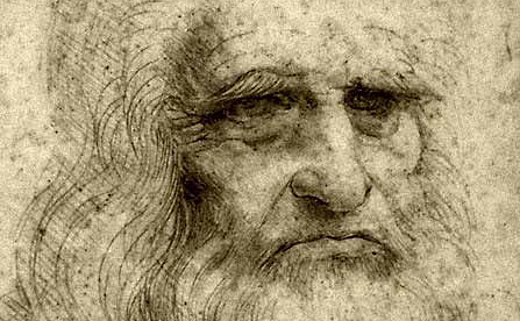In this new article I’ll talk about one of the great masters of the Italian Renaissance, the genius Leonardo Da Vinci (as well as my favorite artist).Sometimes credited with the inventions of the parachute, helicopter and tank, his genius epitomized the Renaissance humanist ideal.So I will tell something anecdote or curiosity that concern him.

1.Maybe Leonardo wasn’t italian: Leonardo di ser Piero da Vinci (Vinci, 15 April 1452 – Amboise, May 2, 1519) was the illegitimate son of Piero, respected notary well introduced in the environments of Florence (the Medicis could also count among its customers). The mother was, according to some, the original of the East. The name Caterina was in fact common among slaves converted to Catholicism. Additionally, the fingerprints of Leonardo detected on Saint Jerome would show similarities with a type common among Arabs.However, it was the father, around 1470, to accompany that his illegitimate son, a teenager, in one of the most important shops of the time, that of Andrea Verrocchio.
2.He realized what was the real function of the heart:
at that time it was still believed that the heart would serve to warm the blood circulating. He was the first to intuit function.
Why some anatomical structures have heart later named after him. For example, the “beam moderator of Leonardo da Vinci” or the “trabeculae arched Leonardo“.
3.He was to bring Mona Lisa in France:
the idea it is still widespread that the Mona Lisa was taken to the Louvre by Napoleon. Instead, it was Leonardo himself to take her with him to France, and King Francis I paid her 4,000 gold crowns (two years of salary of Leonardo). Napoleon’s troops took instead, never return, some manuscripts (now “Codes of the Institute of France“).
4.He was a vegetarian:
Leonardo had one deep love for animals. He was even in the markets to free the birds from cages ready to be sold. A contemporary, the navigator Tuscan Andrea Corsali, said of him that “eats anything that takes blood“.
He is credited with the phrase “The day will come that will be judged crime to kill an animal as a time to kill a man.”
5.He had a taste for the grotesque:
His gaze was attracted not only by the beautiful, but also deformed, and many consider him the founder of the genre of caricature. In fact, there is at least one sheet with drawings of male heads in which the physical characteristics are accentuated to a grotesque effect.See here.
6.He liked to experiment:
The most famous “experiment” of Leonardo was put in place when Ludovico il Moro was commissioned to paint on a wall of the refectory of the convent adjoining the church of Santa Maria delle Grazie, a fresco of the Last Supper. In Leonardo’s fresco technique, who planned to work quickly on the plaster “fresh”, . So he invented one that would allow him to go occasionally to give even a single brushstroke, continuing to follow simultaneously its further education and jobs. Too late he discovered that the painting, well, deteriorated very rapidly when Leonardo was still alive, thanks to the humidity, the Last Supper was reduced to a blur of color indistinct.
7.He had an unusual writing:
Leonardo used a strange mirror writing, running from right to left, and often began to write the last sheet on its way to the first.
This feature has been widely interpreted as an effort deployed by Leonardo to keep secret and incomprehensible his code and his studies.
Those who considered him a heretic went so far as to call it “the writer of the devil” for this particular feature.
In fact, it was his natural way of writing. Neurologists have shown that in fact his was a habit acquired in childhood, natural for lefties that were not corrected as Leonardo. He knew how to use the handwriting “normal”, but with difficulty and only when necessary, such as made in some topographical maps. Not surprisingly, Leonardo did write to his other letters and his letters of recommendation.
8.He told jokes .. And they were also rather dirty.
9.He discover the growth rings of a tree
The first person to observe the growth rings of trees, and to understand that, counting them, you can determine the age of a plant, it was Leonardo. From this observation was born in recent years, a new science, the dendroclimatology, that studying climates of the past thanks to particular traces left by the nature in tree rings.
10.Very shrewd man:
When goes to Ludovico il Moro, in 1482, Leonardo brought with him a letter of introduction (no autograph: perhaps you did not fast help from an acquaintance of diplomacy) that was kind of a curriculum designed specifically. Cunningly he puts in light his skills as a military engineer, just at a time when the Moro cultivated the ambition to expand his kingdom, and only the last point (out of ten) wrote of what he could do “in time peace”.
Throughout the early part is a catalog of works of war that promised to be able to realize, by “bridges light and strong” to “bombards commodissime et easy to wear”, to “covered wagons, securi et inoffensibili”. We do not know how many of these projects were actually carried out, and it seems that the Moro battles rarely made use of Leonardo’s machines. But the letter did its job.
